Abstract
Climate change has been recognized as a threatening environmental problem around the world. CO2 is considered to be the main component of greenhouse gas. By using solar energy (light energy) as the energy source, photocatalytic conversion is one of the most effective technologies to reveal the clean utilization of CO2. Herein, using sodium tungstate, nickel nitrate, and selenium powder as the main raw materials, the high absorption and utilization of WSe2 for light energy and the high intrinsic conductivity of NiSe2 were combined by a hydrothermal method to prepare NiSe2/WSe2 and hydrazine hydrate as the reductant. Then, high-performance NiSe2/WSe2 photocatalytic material was prepared. The characterization results of XRD, XPS, SEM, specific surface area, and UV-visible spectroscopy show that the main diffraction peak of synthesized NiSe2/WSe2 is sharp, which basically coincides with the standard card. After doping NiSe2, the morphology of WSe2 was changed from a flake shape to smaller and more trivial crystal flakes, which demonstrates richer exposed edges and more active sites; the specific surface area increased from 3.01 m2 g−1 to 8.52 m2 g−1, and the band gap becomes wider, increasing from 1.66 eV to 1.68 eV. The results of a photocatalytic experiment show that when the prepared NiSe2/WSe2 catalyst is used to conduct photocatalytic reduction of CO2, the yield of CH3OH is significantly increased. After reaction for 10 h, the maximum yield could reach 3.80 mmol g−1, which presents great photocatalytic activity.
1. Introduction
CO2, whose primary resource is the combustion of fossil fuel and the massive emission of automobiles, is currently ongoing excessive emission. It is the main cause of the greenhouse effect [1,2,3]. An effective measure to address the greenhouse effect is to convert the CO2 in air into organic chemical fuel. Photocatalytic technology has attracted great attention due to its mild conditions, environmental friendliness, effectiveness, no secondary pollution, and other advantages. However, current catalysts have various shortages, such as less-specific surface-active sites, a fast recombination rate of photoelectron–hole pair, low quantum efficiency, and a low absorption and utilization rate of sunlight. Therefore, searching for effective catalysts has become the focus of researchers around the world [4,5,6].
In recent years, transition metal nitride [7], transition metal carbide [8], and transition metal chalogenide [9] have all presented the characteristics of low cost and great catalytic stability. Among them, the two-dimensional layered transition metal chalogenide (TDMC) MX2 (M represents the transition metal element, and X represents S, Se, and Te) has the characteristic of changing from an indirect band gap to a direct band gap during the transition from multiple layers to a single layer [10,11]. At present, there is much research on the preparation and performance of MoS2 and its composite materials, but research on WSe2 compounded with other metal ions has been little studied [12,13]. As the main transition metal chalogenide, tungsten diselenide (WSe2) is a diamagnetic p-type semiconductor material, which locates at a low conduction band (1.16 eV). WSe2 is the material with the lowest thermal conductivity in the world, which indicates that the heat will not be easily dissipated from the system; in other words, the efficiency needed for the system to convert energy will be higher [14].Therefore, the application of this new material with high energy efficiency can be regarded as a significant improvement. Furthermore, when WSe2 changes from bulk material to a single-layer material, its energy gap will vary with the change of layers. At a single layer, the electronic structure will experience significant change, and the 1.2 eV indirect band gap will suddenly change into a 1.8 eV direct band gap. Such a band gap width is very close to the solar spectrum, so WSe2 has high optical adsorption properties and exhibits great application prospects in the fields of photoelectrocatalysis and photoelectric conversion [15]. Besides, WSe2 exhibits dose-dependent toxicological effects compared with other similar inorganic analogues such as MoS2 or WS2 [16]. This character denotes that the hazardous level of this component is relatively low. The two-dimensional layered transition metal chalogenides generally have the problems of poor electrical conductivity, a tendency for aggregation, and difficulty in preparing several layers [17], which has severely affected their catalytic performance. In order to address these problems, the researchers have conducted significant investigations. Yu et al. [18] synthesized reduced graphene oxide (RGO) onto the single-layer WSe2 nanolayer via the one-pot solvothermal reaction. They found that compared with the bare WSe2 nanosheets, the composite material synthesized with RGO has higher photocatalytic activity. Similarly, Wang et al. [19] employed the same method to prepare the multi-walled carbon-nanotubes-modified WSe2 (CNT/WSe2). Based on analysis of their research conclusion, it can be found that when exposed to visible light, the CNT/WSe2 composite material shows increased photocatalytic activity during the photocatalytic decomposition of the organic dye methyl orange (MO). Furthermore, Stuart Licht et al. [20] pointed out that the cationic dissolving salt can affect the photoelectric properties of the WSe2 nanolayer. Moreover, Feng et al., Li et al., and Guo et al. [21,22,23] pointed out that the photopotential and photoelectrochemical cell power can be significantly enhanced when transition-metal chalcogenides were employed for electrodes, especially for MoSe2/graphene and WSe2/graphene nanosheets and core–shell structure of NiSe2 nanoparticles@nitrogen-doped graphene.
According to the reaction process of the photocatalytic reduction of CO2, CO2 must be attached to the active sites of the photocatalyst to further process a reaction, which is the basis of the interfacial reaction. Therefore, the enhancement of the photocatalytic reduction of CO2 reaction can start from the enhancement of carbon dioxide adsorption. In previous studies, a TiO2-based heterostructured photocatalyst and g-C3N4-based heterostructured photocatalyst were also applied to reduce CO2 to produce CH3OH [24]. Yang et al. [25], Liang et al. [26], and Bafaqeer et al. [27] use g-C3N4/CdS, g-C3N4/ZnO, ZnV2O6 /pCN as photocatalytic materials, and the methanol yields were 1352.07 umol g−1, 0.6mmol g−1 h−1, and 3742.19 umol gcat−1, respectively. Qin et al. [28] and Li et al. [29] use CuO/TiO2 and BiS2/TNT as photocatalytic material to produce CH3OH; the yields of CH3OH were 1600 umol h−1g−1 and 224.6 umol−1 g−1h−1, respectively. The results of the study show that carbon dioxide in the solution can be adsorbed on TDMCs to form formate ion. After 3 h of sunlight at room temperature, the system generates methanol photoelectrically. Further mechanism analysis shows that TDMC materials can not only adsorb and activate carbon dioxide but also contribute to the process of photogenerated electron transformation and act as a promoter [30].
In this work, NiSe2/WSe2 was successfully prepared with a hydrothermal method. The main goal is to find a feasible way to catalyze the conversion of the CO2. By doing so, this research intends to see to what extent the CO2 is converted. The overall situation ahead and afterwards, therefore, has been compared. Besides, it is also worth figuring out whether the approach has the value to be promoted or not, say, if it is worthy and feasible enough to be considered as a regular way to treat the ongoing CO2 emission problem. If so, the meaning of this research can thus be applied to a wider scope. Several different plans have been considered, while the choice of WSe2/NiSe2 is due to the access to such material and its relatively high efficiency. The photocatalysis performance of WSe2 by doping NiSe2 to change WSe2 morphology and electronic structure has been improved. Furthermore, its structure was characterized by adopting SEM, specific surface area (BET), XPS, and XRD, and its photocatalysis and CO2 reducing property was also investigated.
2. Materials and Methods
2.1. Preparation of NiSe2/WSe2
The preparation method of the research is with the reference of Cao [31]. Specifically, 1.32 g sodium tungstate (Na2WO4·2H2O) and 0.58 g nickel nitrate were added in deionized (DI) water under stirring, and then the mixture was poured into the mixed solution containing 15 mL HCl solution and 10 mL hydrazine hydrate (N2H4·H2O) to obtain solution A. A total of 0.97 g of selenium powder was added to 15 mL hydrazine hydrate with a concentration of 80%, and then the resulting mixture underwent heating and a reflux reaction for 1–2 h to obtain the precursor B. After that, solution A was poured into precursor B, and ultrasonic treatment was conducted for the obtained mixture until solution A and precursor B were evenly mixed. Next, the mixture was performed on a 100 mL reaction kettle (reactor) and then experienced hydrothermal reaction for 48 h under 200 °C. After reaction and cooling, deionized water was employed to wash the resulting mixture 3–4 times, and then the obtained mixture was moved to the sodium hydroxide solution. Unreacted selenium powder was removed through a heating reaction, and then deionized water and ethyl alcohol were conducted to wash the mixture alternatively until the pH of the mixture was 7. The mixture was then moved into the 60 °C oven for drying. After drying, the mixture was placed into a tube furnace and then underwent reaction for 2–3 h under the condition of 500–550 °C in the nitrogen flow to obtain the NiSe2/WSe2. Figure 1 shows the block diagram of the preparation process of NiSe2/WSe2.
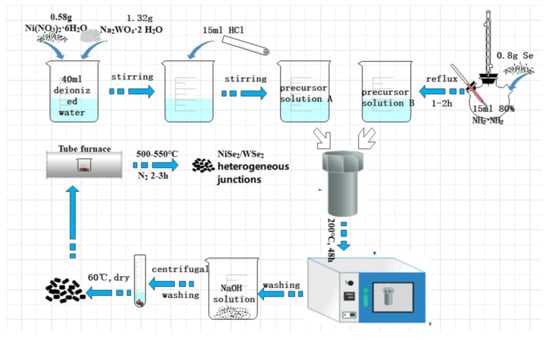
Figure 1.
Block diagram of the preparation process of NiSe2/WSe2.
The process of WSe2 preparation is almost identical to the description above, except for not adding the nickle nitrate.
2.2. Characterization
X-ray powder diffraction (XRD): The Japanese D/MaxRB X-ray Spectrometer was used (Cu target Kα ray) to test the chemical components of samples and their phase composition. The test double angle was 2θ = 10–80°; the UV-visible absorbance spectrum was tested using the ultraviolet-visible spectrophotometer (UV-Vis-8800S, Shanghai, China). The integrating sphere, whose function is to measure the absorbance of the powder sample, was applied in this section for the operation; the BaSO4 tablet was used to test the optical properties of sample, and the measurement range was 200–800 nm; the specific surface area (BET) test was conducted with the NOVA Touch 4LX instrument (Quantachrome Instruments, Boynton Beach, FL, U.S.), which can be used to test the specific surface area and pore size distribution; for the scanning electron microscope (SEM), we adopted the JSM-6700F field emission scanning electron microscope (resolution of 1.0 nm (15 KV)/2.2 nm (1 KV), with an accelerating voltage of 0.5–30 KV). X-ray photoelectron spectroscopy (XPS) was tested by using ThermoESCALAB250XI.
2.3. Photocatalytic Reduction Experiment of CO2
The photocatalytic reduction of CO2, as shown in Figure 2, is conducted in the photocatalytic reactor, which was produced by Beijing Newbet Technology Co., Ltd. (NBeT, Beijng, China). Six quartz tubes were prepared. A total of 50 mL of 0.08 mol L−1 NaHCO3 solution and 50 mg of prepared catalyst were added into each quartz tube, and then magnetic stirring was conducted to evenly disperse the catalyst. Under dark conditions, we continuously injected CO2 for 30 min to remove air and complete the adsorption–desorption balance of CO2 by the catalyst; the 300WXe light was used as the simulation light source. The photocatalysis reaction as conducted by filtering with the 420 nm filter, a 1 mL reaction solution was extracted every 2h, and after removing the catalyst through centrifugation, gas chromatography (GC-920) was used to test the product content. The carrier gas of gas chromatography was high-purity N2, the detector was a hydrogen flame ionization detector (FID), and the chromatographic column was a capillary column; the column temperature was 120 °C, the inlet temperature was 140 °C, and the detector temperature was 160 °C.
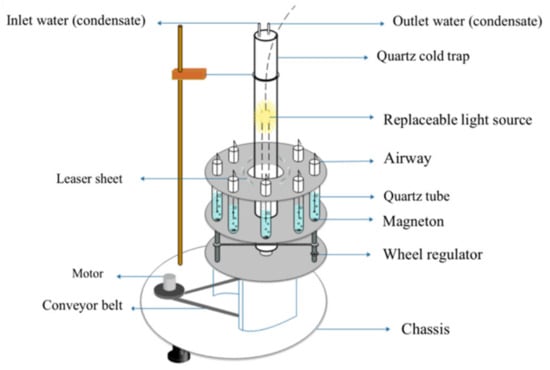
Figure 2.
Reaction device for photocatalytic reduction of CO2.
3. Results and Discussion
3.1. XRD and XPS Analysis
X-ray diffractograms of the synthesized NiSe2/WSe2 were shown in Figure 3.
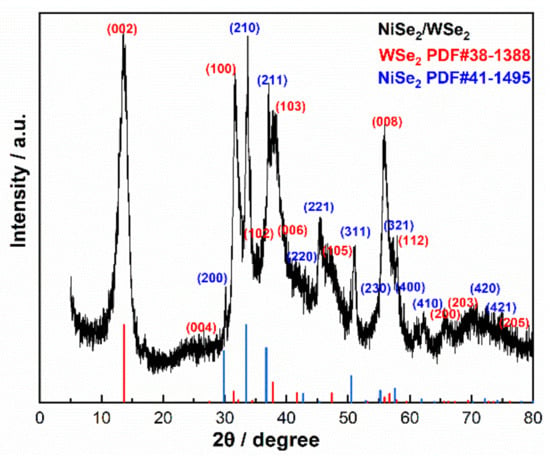
Figure 3.
XRD of NiSe2/WSe2.
According to Figure 3, it can be seen that the main diffraction peak of synthesized NiSe2/WSe2 presents a sharp peak value, and the positions of diffraction peaks basically coincide with the standard cards of WSe2 (JCPDS card, PDF#38–1388) and NiSe2 (JCPDS card, PDF#41–11495). Among them, the diffraction peaks at 13.54°, 31.69°, 32.16°, 34.21°, 37.84°, 47.39°, 56.52°, and 57.92° belong to the (002), (100), (101), (102), (103), (105), (008), and (112) crystal faces of WSe2, respectively. Synthetized WSe2 diffraction peaks were also shown the same characteristics (Figure S1). The characterization results are consistent with those of Jung [32]. The diffraction peaks at 29.89°, 33.41°, 36.74°, 45.37°, 50.48°, 57.57°, 61.82°, 64.01°, and 70.18° belong to the (200), (210), (211), (221), (311), (321), (400), (410), and (420) crystal faces of NiSe2, respectively. This indicates that the synthesized material is NiSe2/WSe2 [33]. In order to further detect the composition and valence of surface elements, the XPS of NiSe2/WSe2 spectrum was shown in Figure 4. Obviously, peaks of Ni, W, and Se were found in the full spectra. In the high-resolution spectra of Ni2p, its peak was composed of two peaks [34], where those at 872 eV and 875 eV were related to Ni2p1/2 and Ni2p2/3, respectively. In the Se3d spectra, the peaks at 55.6eV, 54.2eV were assigned to the Se–Se, Ni–Se bonds. Three peaks positioned at 32.2eV, 35.7eV were ascribed to W4f5/2 and W4f7/2. Similar results were obtained accordingly on the W4f and Se3d high-resolution spectra (Figure S2).
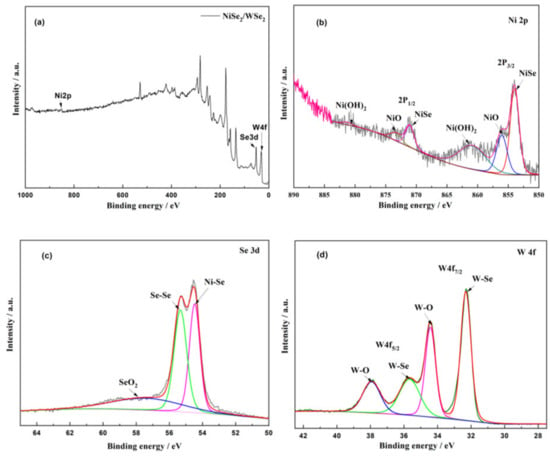
Figure 4.
The full XPS spectra of (a) NiSe2/WSe2, (b) high-resolution XPS spectra of Ni2p, (c) Se3d, (d) W4f.
3.2. SEM Analysis
Figure 5a,b show the SEM images of WSe2 and NiSe2/WSe2, respectively. From Figure 5a, it can be seen that the WSe2 morphology presents the flower shape stacked by many flakes; in Figure 5b, the hexagonal material is NiSe2; after being synthesized with NiSe2, the morphology of WSe2 changes from stacked flakes to smaller and more trivial crystal flakes, which have richer exposed edges and can provide more active sites to contact the CO2 in the reaction solution. In the meantime, the specific surface area is also increased, which is consistent with the results of BET analysis, and this benefits the adsorption of CO2. Furthermore, from these images, it can be seen that NiSe2 and WSe2 present a homogeneous distribution and great dispersibility, which has not only solved the tendency for aggregation of WSe2 but the conductivity of material is also increased, so as to achieve the objective of improving the catalysis performance and stability of NiSe2/WSe2. The EDS image of NiSe2/WSe2 is shown in Figure 5c. The Se/W atomic ratio of the sample is shown in Figure 5d. The X-axis represents the W atom percentage, the Y-axis represents the percentage of Se atom, and the slope represents the Se/W atomic ratio. The Se/W (Ni) = 1.78 in the NiSe2/WSe2 sample. Figure 5d corresponds to the theoretical value of Se / W (Ni) (theoretical value is 2), which further proves that the sample is the target product.
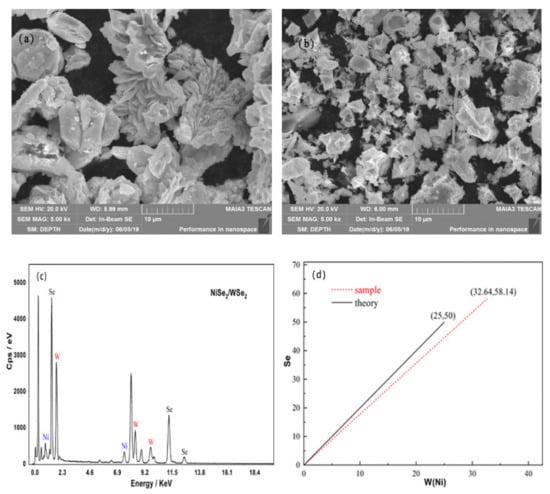
Figure 5.
SEM of (a) WSe2; (b) NiSe2/WSe2; (c) EDS of NiSe2/WSe2; (d) Atom ratio of NiSe2/WSe2.
3.3. BET Analysis
Figure 6 shows the adsorption–desorption isothermal diagram of N2. According to Figure 6, the adsorption isothermal diagram of WSe2 and the desorption isothermal diagram of NiSe2/WSe2 form a hysteresis loop without overlapping, which presents type IV isotherm with hysteresis loop. In other words, after synthesizing with NiSe2, the isothermal diagram of NiSe2/WSe2 is still type IV, which indicates that the introduction of NiSe2 has damaged the mesoporous structure of the material. Figure 6 exhibits the pore diameter distribution curve. According to Figure 7, it could be seen that the pore diameter of WSe2 and NiSe2/WSe2 are mainly distributed in the range of 2–10 nm, but NiSe2/WSe2 still contains very few large pores, which is mainly caused by the distribution of NiSe2.
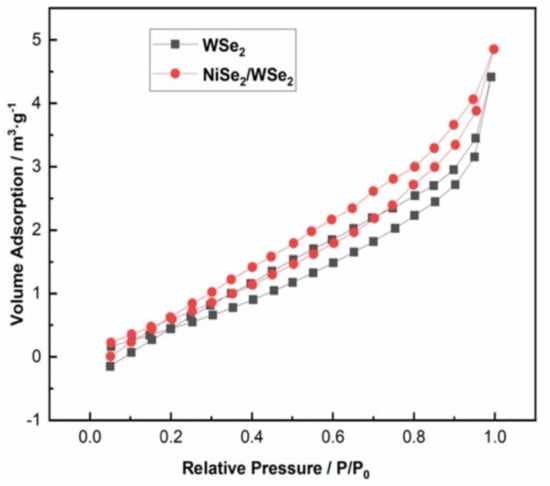
Figure 6.
Adsorption–desorption curve of N2.
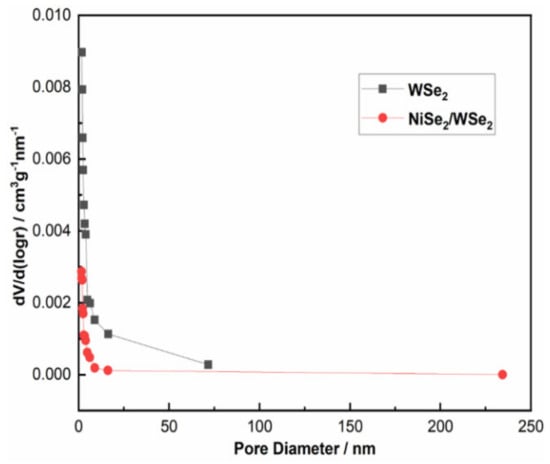
Figure 7.
Pore diameter distribution curve.
Table 1 shows the specific surface area, pore volume, and pore diameter of WSe2 and NiSe2/WSe2. According to Table 1, the specific surface area of NiSe2/WSe2 presents a significant increase compared to that of pure WSe2, which has increased by 1.83 times. This indicates the increase of active sites on the surface of NiSe2/WSe2, which can benefit the adsorption of CO2 and the exchange of CO2 in the pore passage. Its macroscopic expression is the high activity of the catalyst, so that the photocatalysis performance can be further improved.

Table 1.
Specific surface area, pore volume, and pore diameter of WSe2 and NiSe2/WSe2.
3.4. Analysis of UV-Visible Absorbance Spectrum
When WSe2 is a bulk material, it is a 1.2 eV indirect band gap semiconductor, while the direct band gap for single-layer WSe2 is 1.6–1.7 eV. According to Figure 8, it can be seen that WSe2 and NiSe2/WSe2 both show a strong photo response within the range of 250–750 nm. Although they demonstrate different light absorption intensities at different wavelengths, within the wavelength range of 250–750 nm, WSe2 and NiSe2/WSe2 show basically the same variation trend of light absorption intensities, which means that the introduction of NiSe2 has not changed the light absorption performance of WSe2. The intersection line plotting method is employed to plot the absorption wavelength threshold in Figure 8, and it can be obtained that λWSe2 = 748 nm, λNiSe2/WSe2 = 736 nm. By combining formula 𝐸 = ℎ ∗ 𝑐∕𝜆, the band gap widths of WSe2 and NiSe2/WSe2 can be obtained, which are 1.66 eV and 1.68 eV, respectively, indicating that the synthesized WSe2 has a single layer. It has been learnt that because of the combined effects of Ni doping, which in turn cause the increase of energy of the surrounding electronics and the Burstein–Moss effect, the band gap after doping is increased so that the band gap of NiSe2/WSe2 is the larger one. Note that such an increase contributes to the separation of photo-generated electrons and photo-generated holes and reduces the recombination rate of electron–hole pairs; therefore, the effective number of photo-generated electrons and photo-generated holes is increased. The goal of improving photocatalytic performance can be thereby fulfilled.
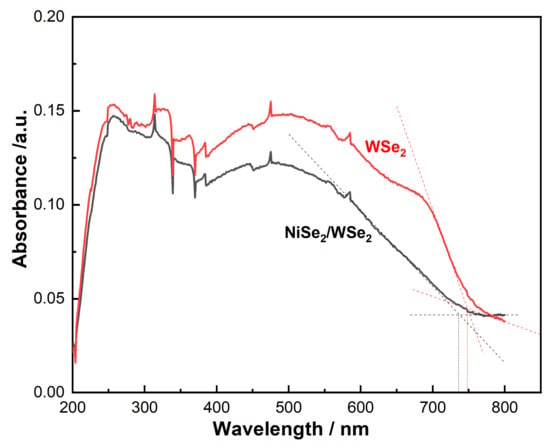
Figure 8.
UV-visible absorbance spectrum.
3.5. Photocatalysis Performance
Figure 9 shows the relationship between the yield of CH3OH obtained from the photocatalytic reduction of CO2 using WSe2 and NiSe2/WSe2 with the time. the comparisons of CH3OH yields between the work and literatures were shown Table S1. According to Figure 9, with the increase of catalysis time, the yields of CH3OH all show an increasing trend when different catalysts are used. However, under the catalytic action of NiSe2/WSe2, the yield of methanol is significantly higher than that under the catalysis of WSe2. During the first 8 h of reaction, the overall yield of methanol shows continuous growth. However, from 8 h to 10 h of reaction, the yield of methanol basically remains the same under the catalysis of WSe2, while under the catalytic action of NiSe2/WSe2, the yield of methanol still exhibits continuous growth, increasing from 3.00 mmol g−1 to 3.80 mmol g−1. This is mainly because NiSe2 and WSe2 have a homogeneous distribution in NiSe2/WSe2, so that NiSe2/WSe2 becomes more dispersed and will not easily aggregate. The conductivity of NiSe2/WSe2, therefore, is increased by the combination of these two materials. Its morphology is presented as the smaller and more trivial crystal flakes, the surface area therefore has been increased, and there are more active sites, all of which can help to improve its photocatalysis performance.
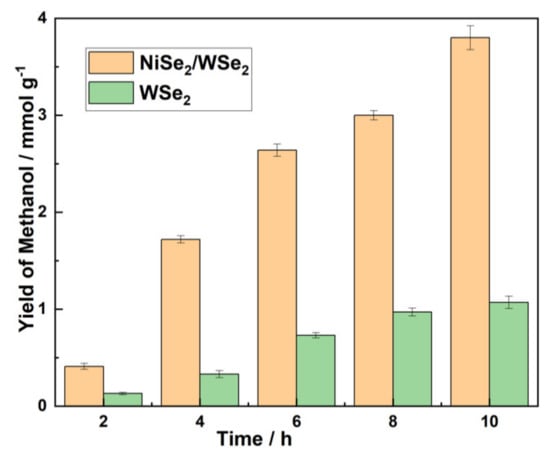
Figure 9.
Relationship between the yield of methanol and the reaction time.
4. Conclusions
In this paper, the hydrothermal method is employed to prepare NiSe2/WSe2. The main diffraction peak of synthesized NiSe2/WSe2 is sharp, and the positions of diffraction peaks basically coincide with the standard cards of WSe2 (JCPDS card, PDF#38–1388) and NiSe2 (JCPDS card, PDF#41–11495); both WSe2 and the synthesized NiSe2/WSe2 demonstrate a strong photo response within the range of 250–750 nm, and the presence of an impurity band and band tail with the introduction of NiSe2 causes the band gap of NiSe2/WSe2 to become wider, from 1.66 eV to 1.68 eV, which is helpful for increasing of the effective number of photo-generated electrons and photo-generated holes. In the prepared NiSe2/WSe2, NiSe2 and WSe2 have a homogeneous distribution, and NiSe2 also makes WSe2 more dispersed; the morphology characterization changes from stacked flower shape to smaller and more trivial crystal flakes, the surface area is increased, and more active sites are provided. The photocatalytic reduction results of CO2 show that the yield of CH3OH is significantly increased: the yield reaches 3.80 mmol g−1 at 10 h of reaction, which is 3.4 times the yield under the catalysis of pure WSe2, and the NiSe2/WSe2 has great photocatalytic activity.
5. Patents
The results studied in this paper have been accepted for a patent in China with the application number 202010247325.5 and named as A photocatalytic carbon dioxide reduction catalyst and its preparation method and application.
Supplementary Materials
The following are available online at https://www.mdpi.com/1996-1073/13/17/4330/s1, Figure S1: XRD of synthetized WSe2, Figure S2: XPS of synthetized WSe2, Table S1: Comparaison of the methanol production between this research and other literatures.
Author Contributions
F.G. gave the main idea regarding preparation of NiSe2/WSe2 and wrote the manuscript; K.Z., Y.Z., and Y.S. prepared the NiSe2/WSe2; Z.L. and Y.L. conducted the XPS, XRD, SEM, and SEM analysis.; Z.L., Y.Z., and Y.L. performed the photocatalytic carbon dioxide reduction experiment. Z.L. and Y.L. helped in preparing the manuscript. K.L. and W.J. supervised the whole work and funding acquisition. All authors have read and agreed to the published version of the manuscript.
Funding
This Project is funded by the Key Research and Development (R&D) Projects of Shanxi Province, China, grant number 201803D121035.
Conflicts of Interest
The authors declare no conflict of interest.
References
- Zhao, S.; Jin, R.; Jin, R. Opportunities and Challenges in CO2 Reduction by Gold- and Silver-Based Electrocatalysts: From Bulk Metals to Nanoparticles and Atomically Precise Nanoclusters. ACS Energy Lett. 2018, 3, 452–462. [Google Scholar] [CrossRef]
- Wan, W.; Tackett, B.M.; Chen, J.G. Reactions of water and C1 molecules on carbide and metal-modified carbide surfaces. Chem. Soc. Rev. 2017, 46, 1807–1823. [Google Scholar] [CrossRef] [PubMed]
- Koyama, S.; Akbay, E.A.; Li, Y.Y.; Herter-Sprie, G.S.; Buczkowski, K.A.; Richards, W.G.; Gandhi, L.; Redig, A.J.; Rodig, S.J.; Asahina, H.; et al. Adaptive resistance to therapeutic PD-1 blockade is associated with upregulation of alternative immune checkpoints. Nat. Commun. 2016, 7, 10501. [Google Scholar] [CrossRef] [PubMed]
- Graves, C.; Ebbesen, S.D.; Mogensen, M.; Lackner, K.S. Sustainable hydrocarbon fuels by recycling CO2 and H2O with renewable or nuclear energy. Renew. Sustain. Energy Rev. 2011, 15, 1–23. [Google Scholar] [CrossRef]
- Stolarczyk, J.K.; Bhattacharyya, S.; Polavarapu, L.; Feldmann, J. Challenges and Prospects in Solar Water Splitting and CO2 Reduction with Inorganic and Hybrid Nanostructures. ACS Catal. 2018, 8, 3602–3635. [Google Scholar] [CrossRef]
- Wang, P.; Wang, S.; Wang, H.; Wu, Z.; Wang, L. Recent Progress on Photo-Electrocatalytic Reduction of Carbon Dioxide. Part. Part. Syst. Charact. 2018, 35, 1700371. [Google Scholar] [CrossRef]
- Eklund, P.; Kerdsongpanya, S.; Alling, B. Transition-metal-nitride-based thin films as novel energy harvesting materials. J. Mater. Chem. C 2016, 4, 3905–3914. [Google Scholar] [CrossRef]
- Xiao, Y.; Hwang, J.-Y.; Sun, Y.-K. Transition metal carbide-based materials: Synthesis and applications in electrochemical energy storage. J. Mater. Chem. A 2016, 4, 10379–10393. [Google Scholar] [CrossRef]
- Asadi, M.; Kim, K.; Liu, C.; Addepalli, A.V.; Abbasi, P.; Yasaei, P.; Phillips, P.; Behranginia, A.; Cerrato, J.M.; Haasch, R.; et al. Nanostructured transition metal dichalcogenide electrocatalysts for CO2 reduction in ionic liquid. Science 2016, 353, 467–470. [Google Scholar] [CrossRef]
- Chhowalla, M.; Shin, H.S.; Eda, G.; Li, L.-J.; Loh, K.P.; Zhang, H. The chemistry of two-dimensional layered transition metal dichalcogenide nanosheets. Nat. Chem. 2013, 5, 263–275. [Google Scholar] [CrossRef]
- Tan, C.; Zhang, H. Two-dimensional transition metal dichalcogenide nanosheet-based composites. Chem. Soc. Rev. 2015, 44, 2713–2731. [Google Scholar] [CrossRef] [PubMed]
- Tang, H.; Dou, K.; Kaun, C.-C.; Kuang, Q.; Yang, S. MoSe2 nanosheets and their graphene hybrids: Synthesis, characterization and hydrogen evolution reaction studies. J. Mater. Chem. A 2014, 2, 360–364. [Google Scholar] [CrossRef]
- Bi, E.; Chen, H.; Yang, X.; Ye, F.; Yin, M.; Han, L. Fullerene-Structured MoSe2 Hollow Spheres Anchored on Highly Nitrogen-Doped Graphene as a Conductive Catalyst for Photovoltaic Applications. Sci. Rep. 2015, 5, 13214. [Google Scholar] [CrossRef] [PubMed]
- Fang, H.; Chuang, S.; Chang, T.C.; Takei, K.; Takahashi, T.; Javey, A. High-Performance Single Layered WSe2 p-FETs with Chemically Doped Contacts. Nano Lett. 2012, 12, 3788–3792. [Google Scholar] [CrossRef] [PubMed]
- Liu, W.; Kang, J.; Sarkar, D.; Khatami, Y.; Jena, D.; Banerjee, K. Role of Metal Contacts in Designing High-Performance Monolayer n-Type WSe2 Field Effect Transistors. Nano Lett. 2013, 13, 1983–1990. [Google Scholar] [CrossRef] [PubMed]
- Teo, W.Z.; Chng, E.L.K.; Sofer, Z. Cytotoxicity of Exfoliated Transition-Metal Dichalcogenides (MoS2, WS2, and WSe2) is Lower Than That of Graphene and its Analogues. Chem. Eur. J. 2014, 20, 9627–9632. [Google Scholar] [CrossRef]
- Wang, H.; Feng, H.; Li, J. Graphene and Graphene-like Layered Transition Metal Dichalcogenides in Energy Conversion and Storage. Small 2014, 10, 2165–2181. [Google Scholar] [CrossRef]
- Yu, B.; Zheng, B.; Wang, X.; Qi, F.; He, J.; Zhang, W.; Chen, Y. Enhanced photocatalytic properties of graphene modified few-layered WSe2 nanosheets. Appl. Surf. Sci. 2017, 400, 420–425. [Google Scholar] [CrossRef]
- Wang, X.; Chen, Y.; Zheng, B.; Qi, F.; He, J.; Yu, B.; Zhang, W. Significant enhancement of photocatalytic activity of multi-walled carbon nanotubes modified WSe2 composite. Mater. Lett. 2017, 197, 67–70. [Google Scholar] [CrossRef]
- Licht, S.; Myung, N.; Tenne, R.; Hodes, G. Cation Electrolytic Modification of n-WSe2/Aqueous Polyiodide Photoelectrochemistry. J. Electrochem. Soc. 1995, 142, 840. [Google Scholar] [CrossRef]
- Feng, J.; Sun, X.; Wu, C.; Peng, L.; Lin, C.; Hu, S.; Yang, J.; Xie, Y. Metallic Few-Layered VS2 Ultrathin Nanosheets: High Two-Dimensional Conductivity for In-Plane Supercapacitors. J. Am. Chem. Soc. 2011, 133, 17832–17838. [Google Scholar] [CrossRef]
- Li, W.; Yu, B.; Hu, Y.; Wang, X.; Yang, D.; Chen, Y. Core-Shell Structure of NiSe2 Nanoparticles@Nitrogen-Doped Graphene for Hydrogen Evolution Reaction in Both Acidic and Alkaline Media. ACS Sustain. Chem. Eng. 2019, 7, 4351–4359. [Google Scholar] [CrossRef]
- Guo, J.; Shi, Y.; Bai, X.; Wang, X.; Ma, T. Atomically thin MoSe2/graphene and WSe2/graphene nanosheets for the highly efficient oxygen reduction reaction. J. Mater. Chem. A 2015, 3, 24397–24404. [Google Scholar] [CrossRef]
- Prabhu, P.; Vishal, J.; Lee, J.M. Heterostructured Catalysts for Electrocatalytic and Photocatalytic Carbon Dioxide Reduction. Adv. Funct. Mater. 2020, 30, 24. [Google Scholar] [CrossRef]
- Yang, X.; Yang, W.; Xin, X.; Yin, X. Enhancement of photocatalytic activity in reducing CO2 over CdS/g-C3N4 composite catalysts under UV light irradiation Chem. Phys. Lett. 2016, 651, 127. [Google Scholar] [CrossRef]
- Yu, W.; Xu, D.; Peng, T. Enhanced photocatalytic activity of g-C3N4 for selective CO2 reduction to CH3OH via facile coupling of ZnO: A direct Z-scheme mechanism. J. Mater. Chem. A 2015, 3, 19936. [Google Scholar] [CrossRef]
- Bafaqeer, A.; Tahir, M. Well-designed 2D/2D ZnV2O6/g-C3N4 nanosheets heterojunction with faster charges separation via pCN as mediator towards enhanced photocatalytic reduction of CO2 to fuels. Appl. Catal. B 2019, 242, 312–326. [Google Scholar] [CrossRef]
- Li, X.; Liu, H.; Luo, D.; Li, J.; Huang, Y.; Li, H.; Fang, Y.; Xu, Y.-H.; Zhu, L. Adsorption of CO2 on heterostructure CdS(Bi2S3)/TiO2 nanotube photocatalysts and their photocatalytic activities in the reduction of CO2 to methanol under visible light irradiation. Chem. Eng. J. 2012, 180, 151. [Google Scholar] [CrossRef]
- Qin, S.; Xin, F.; Liu, Y.; Yin, X.; Ma, W. Photocatalytic reduction of CO2 in methanol to methyl formate over CuO–TiO2 composite catalysts. Chem. Eng. 2011, 356, 257. [Google Scholar] [CrossRef] [PubMed]
- Cardoso, J.C.; Stulp, S.; de Brito, J.F.; Flor, J.B.S.; Frem, R.C.G.; Zanoni, M.V.B. MOFs based on ZIF-8 deposited on TiO2 nanotubes increase the surface adsorption of CO2 and its photoelectrocatalytic reduction to alcohols in aqueous media. Appl. Catal. B Environ. 2018, 225, 563–573. [Google Scholar] [CrossRef]
- Cao, K.S. Preparation and Tribological Properties of WSe2 and WSe2/C Nanostructured Materials. Master‘s. Thesis, Jiangsu University, Jiangsu, China, 2011. [Google Scholar]
- Cho, S.; Park, S.-K.; Jeon, K.M.; Piao, Y.; Kang, Y.C. Mesoporous reduced graphene oxide/WSe2 composite particles for efficient sodium-ion batteries and hydrogen evolution reactions. Appl. Sur. Sci. 2018, 459, 309–317. [Google Scholar] [CrossRef]
- Ge, P.; Li, S.; Xu, L.; Zou, K.; Gao, X.; Cao, X.; Zou, G.; Hou, H.; Ji, X. Hierarchical Hollow-Microsphere Metal–Selenide@Carbon Composites with Rational Surface Engineering for Advanced Sodium Storage. Adv. Energy Mater. 2019, 9, 1803035. [Google Scholar] [CrossRef]
- Gu, C.; Hu, S.; Zheng, X.; Gao, M.-R.; Zheng, Y.-R.; Shi, L.; Gao, Q.; Zheng, X.; Chu, W.; Yao, H.-B.; et al. Synthesis of Sub-2 nm Iron-Doped NiSe2 Nanowires and Their Surface-Confined Oxidation for Oxygen Evolution Catalysis. Angew. Chem. Int. 2018, 57, 4084–4088. [Google Scholar] [CrossRef]
© 2020 by the authors. Licensee MDPI, Basel, Switzerland. This article is an open access article distributed under the terms and conditions of the Creative Commons Attribution (CC BY) license (http://creativecommons.org/licenses/by/4.0/).